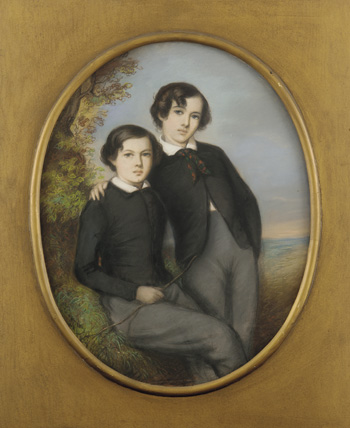Talented Boy
From the age of two, and continuing throughout his life, drawing was one of Whistler’s favorite past-times. By the time he was ten, young “Jemie” was taking a private art lesson every week, but not in his hometown of Lowell, Massachusetts. He was in St. Petersburg, Russia, where his father had been engaged by Tsar Nicholas I to engineer the railroad between Moscow and St. Petersburg. Such was Jemie’s talent that he was next accepted at the Imperial Academy of Fine Arts, taking three classes a week and out-performing students twice his age. He was a prodigy.
“Your little boy has uncommon genius.” – Sir William Allan, artist, 1844

Emile Francois Dessain, “Portrait of J. McNeill Whistler and his Brother William,” 1847, Pastel on paper. Courtesy of the Freer Gallery of Art, Gift of Charles Lang Freer
Beyond the studio training he received in St. Petersburg, visits to sister Deborah and brother-in-law Seymour Haden in London contributed an extra dimension to Whistler’s art education. He toured art galleries, attended lectures at the National Gallery, read about artistic theory, schools of painting, and the lives of great artists. By age fifteen, Whistler had settled on art-making as his career. But further artistic training would take place neither in London nor St. Petersburg. His father had died from the cholera that swept St. Petersburg, and the family returned to the United States. Family connections gained him an appointment to the United States Military Academy at West Point where the cadet received top honors in drawing. But Whistler had never been much for discipline, and disregard for the Academy’s regulations led to dismissal by then Superintendent Robert E. Lee. Whistler’s drawing skills, combined with West Point mapmaking training, gained him a spot at the United States Coast Survey in Washington illustrating coastal maps. The Coast Survey was a critical moment for the young artist. It was there he learned the mechanics of the skill that would gain Whistler his first recognition, etching. The medium of etching was experiencing a resurgence of interest and when Whistler arrived in Paris at age 21, he would take up etching, as well as oil painting, the medium he went to Paris to study. It was an exciting time to be in “the City of Light”; the art world was charged with new ideas. Charles Baudelaire had tasked artists to paint ordinary life, not life’s heroes; Gustave Courbet painted mainly rural scenes with thick applications of paint in a style that came to be called “Realism.” Whistler absorbed both influences, painting and etching men and women of the working class.
Whistler saw his first success in the etching medium. His first collection of etchings, published in Paris as “The French Set” firmly established Whistler’s reputation, and his genius, as an etcher. Its publication marked the beginning of Whistler’s professional artistic career. But recognition for his paintings would soon follow in the city he would now call “home,” London. Whistler’s paintings were accepted in London’s most celebrated circles, namely, the prestigious Royal Academy. His first submission, At the Piano, was compared by one critic to Velázquez, and by another as “the finest piece of painting” in the Royal Academy. Other realistic pictures of London, mostly of the Thames, would also gain acceptance. He was on his way.



